
To be competitive, organizations need continuous improvement efforts working internally and throughout their supply chains. How can this type of system be created so that it is both immediately beneficial and able to maintain its integrity through inevitable leadership and organizational changes? It is critically important to develop a clear mechanism for selecting improvement projects that benefit the business as a whole and avoiding projects that profit a single silo. For this to occur, a business needs a methodology in which the enterprise-wide metrics that need improving drive projects that will enhance key performance indicators, and in which the owners of those metrics are asking for timely project completion.
It is possible to map out and align organizational processes (with associated metrics and supplier integration) to gain an improved understanding of the system throughout an organization – from those in operations to senior management. This increased knowledge of the system results in the most beneficial continuous improvement projects for uncovering the root causes of inefficiencies and defects.
The 9-step process shown in Figure 1 illustrates a system for business management.1 The nine steps integrate improvement efforts with scorecards, and analytically and innovatively determine strategies so that a company as a whole benefits.
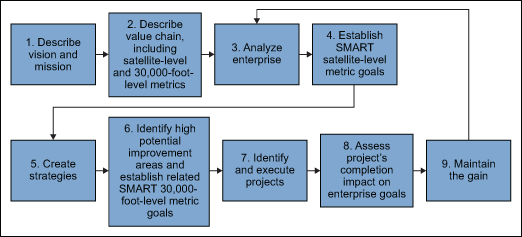
Application of the Business Management System
The following example illustrates the application of this system. A manufacturing firm wants to initiate targeted improvement projects that address opportunities identified through voice of the customer (VOC). (Although a manufacturing firm is used in this example, the approach applies equally well to service and other organizations.) Described in this system is not only a process for the identification of improvement projects that have enterprise-as-a-whole benefits, but also a methodology in which process owners will be asking for, if not demanding, timely completion of projects in their area.
Step 1: Describe Vision and Mission
The company’s executive team agreed to the following:
- Vision – Become a preferred supplier for all major department store chains – that is, have a branded display section in those stores.
- Mission – Produce plastic injection molded items for consumer use.
Step 2: Describe Value Chain, Including Satellite-level and 30,000-foot-level Metrics
The value chain shown in Figure 2 details what the company does [rectangular boxes] and notes the performance measures for each function from a quality, cost and time perspective [oblong boxes].1,2 External customer metrics are highlighted in blue.
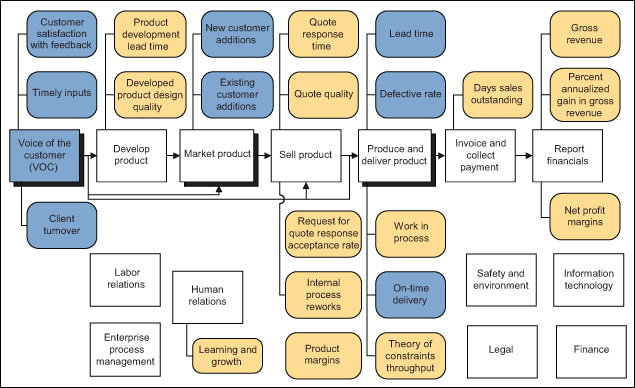
From the value-chain business functions shown in Figure 2, it can be inferred that a relationship exists between the defective-rate metric and VOC satisfaction. That relationship implies that a reduction in defective rates would lead to both improved customer satisfaction and corporate profitability.
With this performance scorecard system, satellite-level metrics focus on the financials (e.g., profit margins) while 30,000-foot-level metrics track operational performance metrics (e.g., defective rates and on-time delivery). Both corporate satellite-level and 30,000-foot-level metrics are tracked over time and are unbounded by calendar years. When a metric chart shows a recent region of stability, the process is called predictable. Data from an earlier region of stability can be used as a random sample when making a prediction statement. If an organization does not like what is predicted, process improvements must be made to the driver of that metric.
To achieve long-lasting benefits, VOC initiatives and other improvement efforts need executive management support. For this to occur, it is imperative that the process enhancement efforts align with financial goals.
The example manufacturing company, then, first needed to create a baseline for the satellite-level metric, profit margins. From that, the business looked at what could be done to improve profitability while still working to achieve its customer satisfaction and retention vision.
Figure 3 shows the profit-margin baseline for the example manufacturing company.2
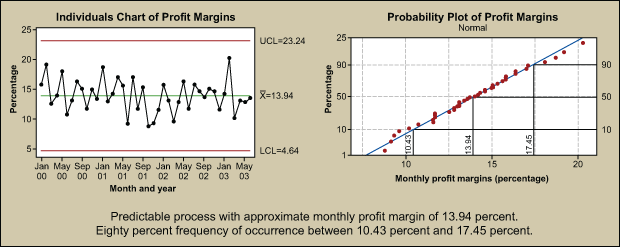
Step 3: Analyze the Enterprise
Next, the company needed to determine the 30,000-foot-level metrics in the value chain that could be improved to address VOC inputs and the financials (such as shown in Figure 3) so that the enterprise as a whole benefited.
This analysis showed several opportunities for improvement to the bottom line. One opportunity was a 2-percentage point reduction in defective rates, which would not only reduce the primary customer complaint but also increase profit margins by 0.5 percentage points. A baseline of this defective-rate 30,000-foot-level metric is shown in Figure 4, along with a Pareto chart of encountered defect types.2
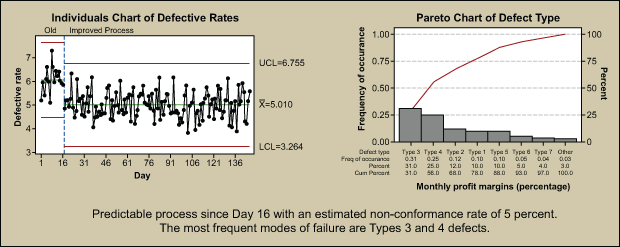
Step 4: Set SMART Goals for Satellite-level Metrics
Profit margins in the manufacturing company’s industry average 16 percent. With its initial average of about 13.9 percent, as shown in Figure 3, the company set a goal to achieve a monthly average profit margin of 16 percent in 12 months. Basing the goal on the industry average was not an arbitrary target, which could lead to unhealthy behaviors, but rather addressed the achievable aspect of SMART goal setting. (SMART goals are specific, measureable, achievable, relevant and timely.)
Corporate management understood that in order to achieve this goal, structured process improvement efforts needed to be undertaken (i.e., the improvement needs of the performance metrics were “pulling” for the creation of projects that benefited the entire enterprise). The business assured the alignment of projects to overall business needs through the development of an enterprise improvement plan (EIP), as described in the next step.
Steps 5 and 6: Create Strategies and Set 30,000-foot-level Performance Goals
A SMART goal was set to reduce the current 5-percent defective rate by 2 percentage points in 6 months. The owner of the defective-rates metric was responsible for meeting that goal. In any organization, this accountability leads to process owners who uphold the need for the judicious completion of projects.
The alignment of this VOC/business strategy and goal with other organizational needs is shown in the partial enterprise EIP in Figure 5. From the figure, it can be noted that strategies and improvement efforts may overlap. In the case of the manufacturing company, targeting defective rates led to two projects on reducing the occurrence of two types of defects.
Through this EIP, initiatives were identified that supported both the VOC issue and an improvement in the financials.
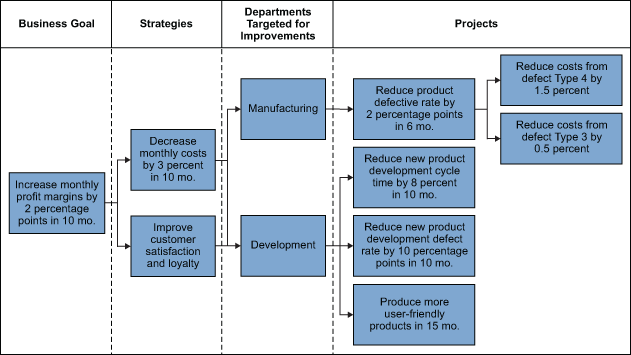
Step 7: Execute the Improvement Project
Various improvement techniques can be used to achieve process improvement goals, including:
- Lean Six Sigma – to address common cause or chronic problems
- Root cause analysis – when a clear special cause exists
- Plan, do, check, act (PDCA) – when targeting a series of small potential incremental improvements
- Just do it – for obvious changes
For the defective rate improvement projects, which have common-cause issues, the team chose to follow the Lean Six Sigma DMAIC (Define, Measure, Analyze, Improve, Control) roadmap.
Steps 8 and 9: Assess Project’s Completion Impact on Enterprise Goals and Maintain the Gain
For the example manufacturing company, success was seen with an improved level of performance measured at the project’s 30,000-foot-level metric. If the magnitude of this shift had not achieved the goal, additional work and/or analysis would have been needed.
In general, this assessment should also evaluate whether any additional costs and effort are appropriate from the enterprise point of view. The process improvements and their controls need to be integrated with the organization’s value chain system (Step 2 of the business management system in Figure 1).
Step 9 of the business management system loops back to Step 4 for additional analysis and improvement efforts.
Summary
Practitioners of process improvement strive to determine what can be done to improve areas of the business they have been assigned to investigate; however, often these efforts take place in silos where such improvements are not felt by executives who are examining the enterprise as a whole. Further, the management of an organization is not typically viewed as a process with its associated improvement opportunities.
These nine steps provide a systematic approach to improving the enterprise system as a whole and how it is managed.
References
-
- Breyfogle, F. W. Integrated Enterprise Excellence Volume II – Business Deployment: A Leaders’ Guide for Going Beyond Lean Six Sigma and the Balanced Scorecard. Citius Publishing, Austin, Texas, 2008.
- Breyfogle, F. W. Integrated Enterprise Excellence Volume III – Improvement Project Execution: A Management and Black Belt Guide for Going Beyond Lean Six Sigma and the Balanced Scorecard. Citius Publishing, Austin, Texas, 2008.